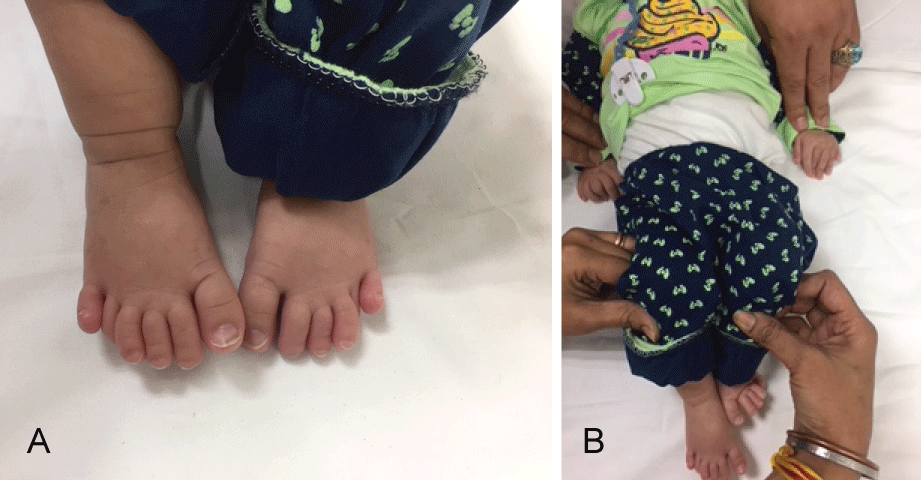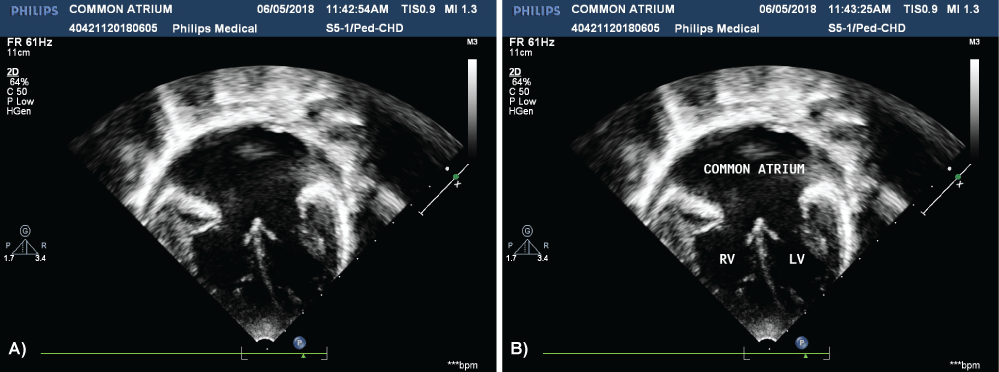Ellis van creveld Syndrome (EVS) is a rare genetic disorder involving predominantly bones and heart. We report a case of 1 year 2-months-old female child with EVS with positive similar family history in elder sibling. Our patient had classical bilateral postaxial polydactyly of hands and feet associated with congenital heart disease.
Polydactyly, Common atrium
EVS: Ellis Van Creveld Syndrome
1 year 2-months-old female child presented to our institution with complains of rapid breathing, failure to gain weight and increase precordial activity. There is no history of consanguineous marriage. Antenatal, natal and post-natal history were not contributory. Elder sibling had similar history. On general examination patient had a short stature with bilateral postaxial polydactyly of hands and feet (Figure 1a and Figure 1b). Cardiovascular examination revealed increased precordial pulsations, loud P2, Ejection systolic murmur of grade 3/6 at left upper sternal border, grade 4/6 pansystolic murmur at apex. Echocardiogram showed common atrium (Figure 2a and Figure 2b) with severe Left Atrio-ventricular valve regurgitation. Based on the clinical and echocardiographic findings with positive family history, the patient was diagnosed to have Ellis Van Creveld Syndrome. Child was started on decongestive therapy and afterload reducing agents. Child was operated with septation of atrium and repair of mitral valve. Postoperative recovery was uneventful and child was discharged in stable condition.
Ellis Van Creveld Syndrome is a rare genetic disorder with autosomal recessive inheritance. The most common clinical feature is shortened long bones of the limbs also called as acromesomelic dwarfism [1-7]. The other features include polydactyly usually bilateral postaxial hexadactyly most often seen in upper limbs on ulnar side and involves lower limb in 10% of cases. They also have wide hands and feet, sausage shaped fingers and dysplastic fingernails [1,7]. Our patient had hexadactyly in both of upper and lower limbs. Other features include genu valga, talipes equinovarus, talipes calcaneovalgus [3] and pectus carinatum with a long narrow chest [1,3,7]. Congenital heart malformations are described in a 50-60% of patients. Most common cardiac anomaly is common atrium. Other cardiac diseases include ventricular septal defect, patent ductus arteriosus, mitral and tricuspid valve disease and rarely hypoplastic left heart syndrome. Our patient had Common atrium with mitral valve cleft leading to severe regurgitation which was repaired successfully.

Figure 1: a.b) Patient had a short stature with bilateral postaxial polydactyly of hands and feet.

Figure 2: a,b) Echocardiogram showed common atrium.